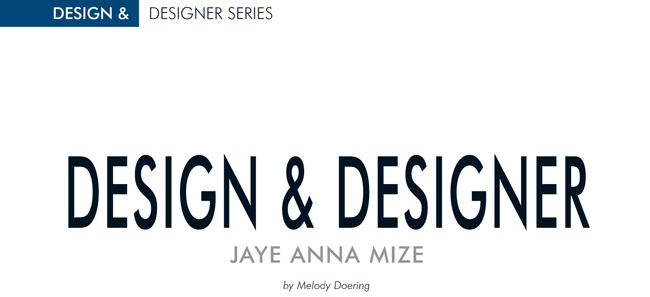
Fashion Snoops' Jaye Anna Mize shares what brands and
retailers can do to connect the dots between culture, consumer behavior and new product development.
This month, Furniture World’s Design and Designer series presents an idea-filled interview with Jaye Anna Mize, VP of Creative | Home Interiors and Design, at the trend-forecaster Fashion Snoops. As Jaye describes it, “Fashion Snoops is an online trend agency and consumer behavior platform.”
Music & Trend Forecasting
“Born and raised in Eden, North Carolina, I was a notorious risk taker. After flunking out of a private all-girls school I decided to move to New York on short notice. A week later I landed a job at Fashion Snoops. At that time the company was developing a line of Kenny Chesney Hawaiian shirts for JCPenney. My bosses didn't know much about country music stars, so they were very happy to have a 19-year-old southern girl on their team to tell them anything and everything about country music. I soon became the assistant to Lilly Berelovich, Co-founder, President and CCO, while going to school at night.”
“A year later I transferred to the University of North Carolina at Greensboro to get a fashion design degree while working remotely doing runway analysis. When I returned to New York I opened the home division at Fashion Snoops.”
Fashion Snoops
“At Fashion Snoops we study consumer behavior, culture and lifestyles, similar to a financial trend forecaster, but on a product development level to help companies create smarter solutions for their product development needs. We work in fashion, beauty, home furnishings, and other industries, with a range of clients that extends from luxury all the way to mass market.”
“Our core focus is on studying culture to get a deep understanding about what's happening – full spectrum – then diving down into product development. From there, we break it down for clients depending on their needs for serving the luxury, mid-market, mass market, boutique-shop market, etc.”
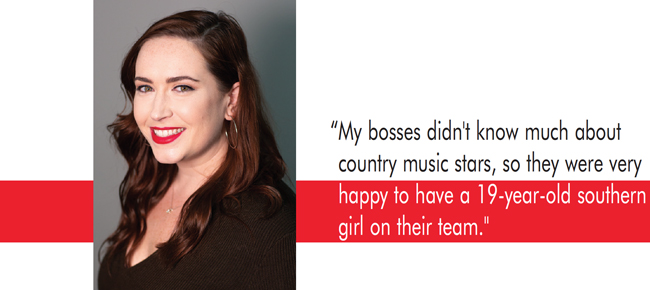
Forecasting Process
“We discuss everything from economics to politics to cultural shifts, cool things in art, color and pattern direction, for example. We look at all this data-mined information objectively to forecast trends.
“Furnishings designers are working anywhere from one to two years out, so we have to have our heads even further out in the game.
“Practically speaking, following news of a recession, or political uncertainty, consumer attitudes and buying behaviors are affected. Designers, furnishings brands, and retailers should factor this into their product development and buying plans. As sad as I am to predict this, due to this kind of uncertainty, Fashion Snoops thinks that in the furniture industry we will start seeing a grey-color shift returning to the forefront, but with tints of blue, green and purple undertones for a softer feel. Design will become minimalist, as patterns become less dominant and practical instead of wild and fun for core items.”
Trend: A Five-Letter Word
“I am not particularly fond of the word ‘trend.’ Designers often say that they don’t follow the latest trends in their creative process. My feeling, however, is that they actually do follow trends, without realizing it. Market-goers can become trend-oversaturated.
“Is it pink or purple or orange or grey or blue? Bohemian or shabby chic or what not. Everybody has an opinion on what the trend is. The word 'trend' has become a marketing term. What designers really need to understand is consumer behavior. By the time a designer or product developer sees the Pantone color of the year at Market, it's too late.
“Designers want to be individualistic; that’s the reason they shy away from the idea of trends. But how can they stand out, and remain authentic when everything's so over-saturated thanks to Instagram? We're at a very interesting moment.”
Social Media Influencers
|
“Right now, Fashion Snoops sees a huge shift in consumer behavior and preferences with regard to the home.” |
“Instagram is having a big influencer moment, trying to remain authentic. Justina Blakeney, for example, (www.justinablakeney.com) is probably the most authentic person on Instagram. She has really carved out that niche of bohemia better than anyone. Justina has a million Instagram followers, and she will not lose them, because she is so authentically herself, inventive with her color schemes and patterns, and always one step ahead. I think that's what people really want from designers and influencers, authenticity! It’s the new trend!”
Shifts in Consumer Behavior
“Right now, Fashion Snoops sees a huge shift in consumer behavior and preferences with regard to the home. It used to be that shoppers would buy, for example, blankets and sheets, then keep these soft goods for as long as they owned their bedroom set, or until they wore out. That's less true today. Consumers are changing them as frequently as they change their other fashion items. However, that’s not true for furniture.
“Younger consumers are replacing those items a lot faster and since this demographic is more likely to work from home and move more frequently, they are looking for more fluid/flexible pieces of furniture that are also a lot less heavy. ”
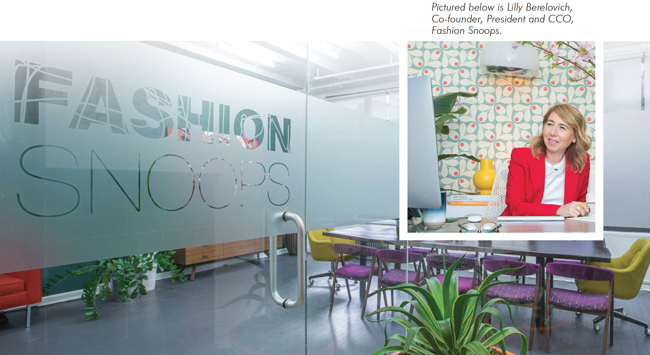
“Many furniture manufacturers and retailers still try to have their product lines encompass every single trend, and every single scale. What they're going to have to consider is to find a style niche for themselves. It might be shabby chic, bohemian, or modern. Then from there, expand that selection to include smaller and larger pieces, and more flexible furniture items. That way manufacturers and retailers can find a unique voice that will appeal to the needs of specific consumer demographics.”
Affordable & Flexible
|
“Some stores think
their job is to buy and sell product, but it’s
really customer service. In today’s market,
retailers must help
shoppers to aspire to
elevate their lives.
” |
“For example, some beautiful higher-end, established furniture brands are not at all affordable on many platforms for younger demographics. They lack flexibility and they don’t travel well. If this trend holds, these manufacturers and their retailers are going to have to reconsider the price, flexibility and scale of their offerings to make them more convenience-driven and seamless.
“It’s interesting that we are seeing millennials influence the buying strategies of baby boomers. They are quick to buy products they see on Instagram. Tired of this bed? No problem! If you are part of a younger or older group, it’s much more convenient to buy from Wayfair, get it quickly, have it delivered, and have it set up. The millennial generation is teaching their parents.
"For furniture retailers, addressing wasted space in their customers' homes, can result in re-purposing those spaces and selling more furniture."
“Fashion Snoops calls the generation above the baby boomers the ‘Third Act’ generation. They saved heirlooms for their children and grandkids, and now they're stuck with all this furniture. Younger generations don't want anything their parents have, because they are constantly on the move. It's nuts. They are freelancing all over the world. The result is that this large group isn’t considering buying what many retailers are selling. And for those who do, right now, they want it to be relatively cheap. If they are willing to buy a more expensive home furnishings piece, they may feel more comfortable buying from the direct to consumer movement, a company like Joybird (www.joybird.com). Casper is another great example of DTC.”

Learning About Customers
“Retailers need to take a closer look at their present customers, average spending, demographics, and incomes. Then they should compare this data to the same metrics for all consumers in their trading areas. Finally, breaking out sales metrics by category will determine if a store, its price levels, marketing, visual merchandising and product selection are aligned and appropriate.”
“There’s a lot of room for furniture retailers to adapt their brick and mortar experience to compete with online retailers by creating an enjoyable in-store experience. When consumers shop for furniture online, they are probably drinking wine in the comfort of their own homes. People want to experience this same kind of comfort and hospitality when they visit brick and mortar stores.
“They gravitate towards specific genres of trends, for example, bohemian, shabby chic or modern. And, are looking at mass market or boutique retailers that don't necessarily show the same exact things, with items differentiated depending on quality and price point.
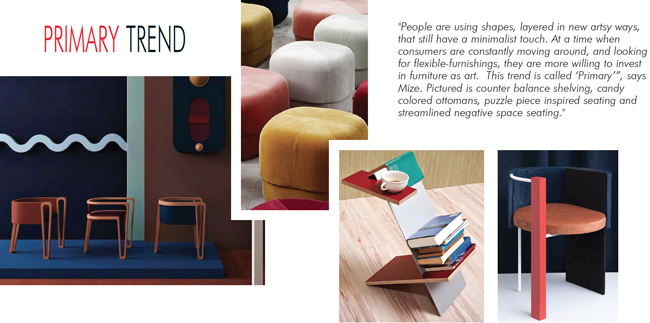
Selling a Lifestyle
“Retailers in today’s market can also benefit from selling a full lifestyle, not just a piece of furniture. That means going even further than selling a bed with bed sheets, throws, pillows, and a chair. Retailers must make their shoppers feel amazing. Furnishings shoppers go to stores because they can't figure out what to buy on their own, at home behind a computer. If they could, they would buy online or choose their furnishings using Pinterest. Some stores think their job is to buy and sell product, but it’s really customer service. In today’s market, retailers must help shoppers to aspire to elevate their lives.
“The biggest opportunity we see at Fashion Snoops across all markets is retailers who create an overall lifestyle look and feel. The best retail stores are bringing in many more product opportunities. They used to be comfortable just carrying a few, closely related product categories. That doesn't really grab the attention of consumers anymore because they want an overall lifestyle look.
“Lots of stores, even fashion stores and hairdressers have incorporated a wine experience, coffee bars and food. This has become important to customers who are spending time and potentially spending a lot of money on furniture. It may sound crazy to the average furniture store owner, but it’s true.”
“Experiential marketing
is important. That includes creating and posting more events, plus
information that’s fun and quirky to bring out their corporate personality. ”
Showing That Lifestyle
|
“Lots of stores, even
fashion stores and
hairdressers have
incorporated a wine experience... It may sound crazy to the average furniture store owner, but it’s true.” |
“Retailers need to create great visual merchandising. If they sell beds, for instance, they should also have sheets; then why not sell picture frames for their customers’ side tables? Filter everything around a color scheme, add in a couple of patterns, and go from there. Sometimes, however, furniture store environments here can be too vignetted, clunky, a step back in time when compared to furniture stores in Europe.
“Some retail brands have websites that feel like they are trying to catch up. It’s hard or impossible for consumers to easily find where to buy their products. The same goes for furniture stores. They feel dated and it’s not a seamless buying experience.
“ABC Carpet & Home, for example, provides an aspirational dream experience. Leon & Lulu, based in Michigan, presents a super cute experience.
“Owner Mary Liz travels and buys from unexpected vendors. She develops great relationships with them and creates interesting stories that may not be related to the utility of those products. The store doesn’t have an overwhelming presence, like some big furniture stores, which is really nice.”
Experiential Marketing
“Beyond visual merchandising, which is an obvious challenge for many furniture retailers, a focus on experiential marketing is important. That includes creating and posting more events, plus information that’s fun and quirky to bring out their corporate personality. The value of a corporate story cannot be over-estimated. In addition, we are seeing more collaborations and cross marketing among stores, especially with other fashion brands. Collaborations create cross promotion and excitement. Your collaborator doesn’t need to even be similar to you to create synergy and be kind of fun.
“Outside of the furniture industry, brands like Rihanna, Virgil Abloh are leading the way. They understand what it means to tap into both mass and also luxury markets. Rihanna has been doing this with, Fenty Beauty by Rihanna (fentybeauty.com) and her clothing line where shoppers can buy straight from the runway. They don't have to buy from an actual store, or wait six months. Virgil Abloh has partnered with IKEA and Rimowa, the luggage brand owned by LVMH, building lifestyle looks.
The Art World
“Perhaps the biggest thing that the furniture industry is missing out on is what’s happening in the art world. We're starting to see more people from the art world create smaller concept home brands, which is quite interesting. They're trying to tell us that our customers are searching for what home is from a cultural angle.
“If retailers and brands visit shows like Art Basel (artbasel.com) and Design Miami (designmiami.com), they will see a ton of home, furniture, and textile design. It’s an opportunity to tap into their creativity through collaboration with some cool young talent.”
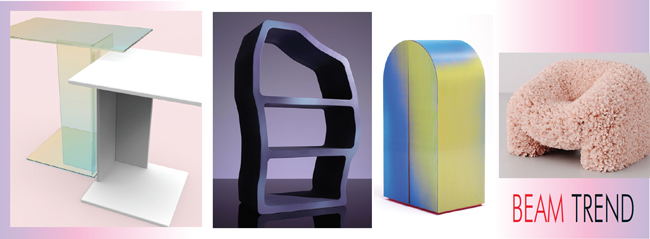
“Gradient coloring and color waves are coming to the home, especially in furniture," says Mize.
“There are iridescent sheens, lots of transparency within surfaces and translucent resins in colors like lavender and peach."
Images above include translucent resin tables, amorphously shaped shelves,
a color changing wardrobe and a highly ”
textural chair.
An Instagram Moment
“Retailers should encourage their suppliers to develop more useful marketing materials so they can do a better job of telling stories about where the furniture they sell is coming from, create transparency, and give customers information they can share with friends and shout out on Instagram. The number one topic on Instagram is people's homes. People are creating Instagrammable moments in their homes. It doesn’t matter if the topic is a furnishing purchase or their dog, they'll Instagram it left, right, and center.
”Consumers want to be able to tell the stories of how the products they purchase are made, so retailers and manufacturers need to coordinate on a cultural and technological level to develop that information faster and increase transparency.
“They want to know who made the products they buy, where they came from, how they were made and why. The more money they spend, the more they want to know. Was it made in an ethical way, a sustainable way, a cool way? These are facts that will find their way onto Instagram.
“The home is an extension of social media. When consumers see a piece of furniture in a retail store or on Instagram, it reminds them of where they were or how they see themselves. It’s a story they can tell, maybe in a subtle, less ornate way. Furniture becomes a backdrop, a canvas for all the accessories that they buy and change with greater velocity today.”
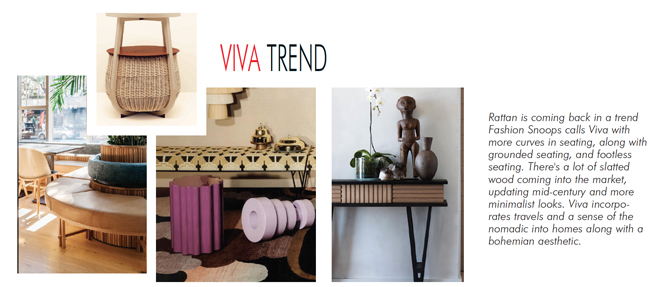
Trends to Watch
Rattan: “We're seeing rattan coming back, with more curves in seating along with grounded seating, and footless seating. Flexible seating is huge. There's a lot of slatted wood coming into the market, which is updating the Mid-century and more minimalist looks.
Accessories: “Consumers are changing out their accessories and soft goods a lot more frequently. Home accessories and soft goods have become, in a sense, ‘fast fashion items'. They can easily be changed and updated without any emotional connection. Therefore, consumers want cleaner, more minimalist spaces and furniture to act as sort of a neutral base.
Minimalism: “That’s why we see a trend towards minimalism in furniture with softer wood finishes, and the use of limestone, a nice neutral stone. Also, lots of mixed media including wood, and woven leather for dining chairs. That's an important trend. We're seeing this in sling chairs for the living room, plus rattan and cane weaving.
Gradient coloring: “In the European market there is a surrealist trend in upholstery that feels overly cozy and sensory but with a fantasy look and a youthful feel. Lots of gradient coloring and color waves are coming to the home, especially in furniture. It's really pretty. There are iridescent sheens, lots of transparency within surfaces and translucent resins in colors like lavender and peach.
Primary shapes: “Be on the lookout for primary-shape play in everything from occasional and dining tables to seating. People are using shapes, layered in new artsy ways, that still have a minimalist touch. At a time when people are moving around, and looking for flexible-furnishings, they are more willing to invest in furniture as art. Retailers should be on the lookout for more artistic chairs, eclectic side tables and shelving as well as statement pieces, primary shapes and colors, lots of storage solutions, and convenience options.
Bohemia: “here’s a resurgence of a bohemian feel with more specificity than previously seen. It’s less maximalist and more refined, without a ton of pattern. This include vibrantly painted wooden pieces, jewel tones, rattan, wooden legs, and small detailed accents -- items that look like they could have been collected while traveling, bringing a storytelling aspect to homes.
Classicon: “Another trend story Fashion Snoops calls Classicon is one of our favorites. Classicon is minimalist classic, an update of classic pieces with new polishes and forms. Chic marble designs are back, but hollow on the inside to make them lighter.
Natural materials: “Look for carved wood in really intricate forms. Wood grains stained in dark indigos, greens and blacks have become a strong artistic furniture design statement. We see lots of plays off natural materials like alabaster or raw rocks. It’s a clean minimalist way to bring nature indoors, a great look for creating calming spaces, wellness, a feeling of ease with a chic, modern, artistic edge.
Mixing it up: “There’s not as much mixing old and new; instead, contemporary pieces are being mixed with items that tell a story. It’s as if a lamp or accent piece was found while traveling to Thailand, India or Spain. These items say, ‘This is who I am. The items in my home tell about the experiences I’ve had. This is my story.'
“In short, what we see coming to the forefront is texture, a juxtaposition of shape and detail; minimalist design with furniture becoming the backbone of the design, clean and simple. It feels sleek while making a beautiful statement, we go back and forth about minimalism and statement pieces so not to contradict ourselves.”
Furniture World is the oldest, continuously published trade publication in the United States. It is published for the benefit of furniture retail executives. Print circulation of 20,000 is directed primarily to furniture retailers in the US and Canada. In 1970, the magazine established and endowed the Bernice Bienenstock Furniture Library (www.furniturelibrary.com) in High Point, NC, now a public foundation containing more than 5,000 books on furniture and design dating from 1620. For more information contact editor@furninfo.com.